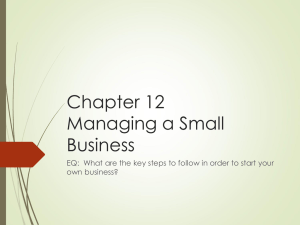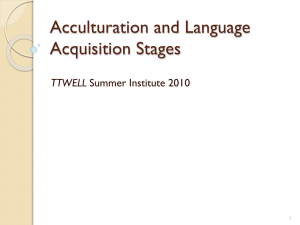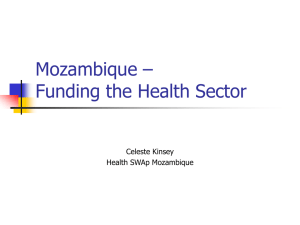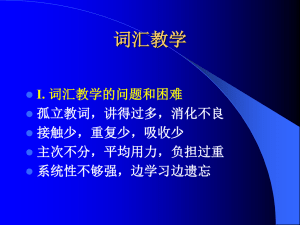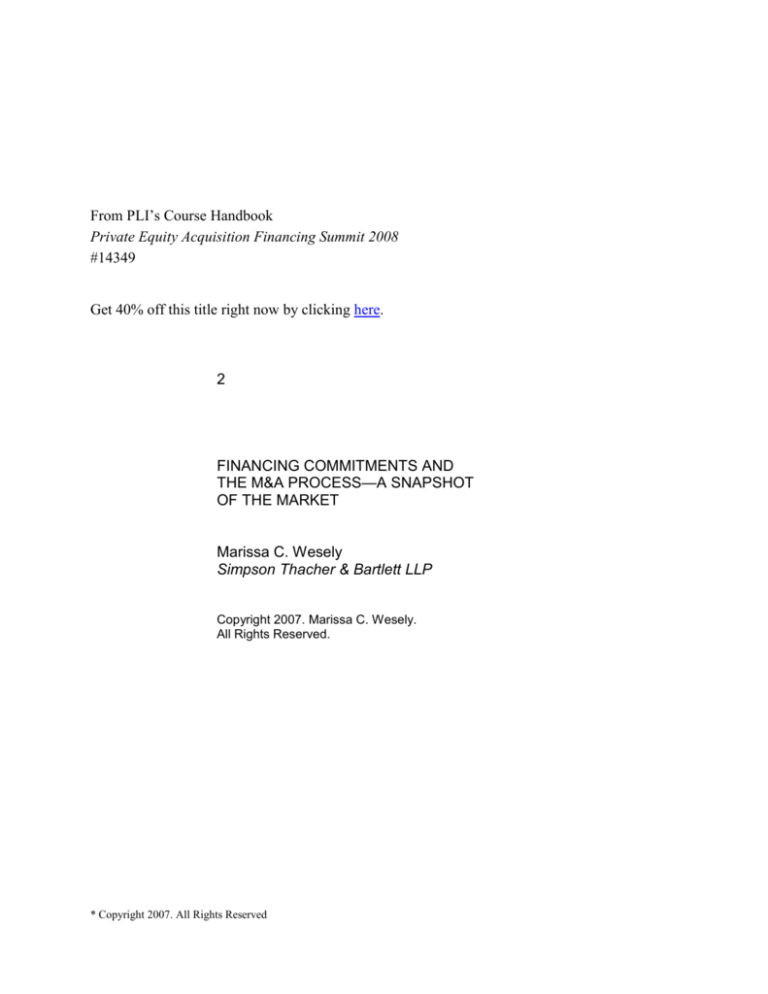
From PLI’s Course Handbook
Private Equity Acquisition Financing Summit 2008
#14349
Get 40% off this title right now by clicking here.
2
FINANCING COMMITMENTS AND
THE M&A PROCESS—A SNAPSHOT
OF THE MARKET
Marissa C. Wesely
Simpson Thacher & Bartlett LLP
Copyright 2007. Marissa C. Wesely.
All Rights Reserved.
* Copyright 2007. All Rights Reserved
2
MARISSA C. WESELY
Partner, New York Office
Marissa C. Wesely is a Partner at Simpson Thacher & Bartlett LLP where she is a member of the
Firm's Corporate Department. Ms. Wesely specializes in domestic and international bank
finance transactions, with an emphasis on leveraged acquisition finance, principally advising
equity sponsors and corporate borrowers in connection with senior lending facilities and
subordinated bridge loans. Recent representations include: Sageview Capital and KKR in the
financing of their acquisition of a 70% stake in ACTS L.P.; Centerbridge in its financing of the
acquisition of GSI; The Blackstone Group in the financing of its acquisition of Team Health; and
CB Richard Ellis in the financing of its acquisition of Trammell Crow.
Earlier in her career, Ms. Wesely designed and taught courses on international trade and
financing for the former Harvard Institute of International Development in China and Indonesia.
She is a regular speaker at the Practicing Law Institute, most recently at its Private Equity
Acquisition Finance Summit in November 2006.
Ms. Wesely joined Simpson Thacher in 1980 and spent three years in the Firm's London office.
She became a partner in 1989. She graduated from Williams College in 1976, magna cum laude,
and received her J.D., cum laude, from Harvard Law School in 1980.
3
Financing Commitments and the M&A Process –
A Snapshot of the Market
October 15, 2007
Marissa C. Wesely
Simpson Thacher & Bartlett LLP*
Introduction
For private equity funds, commitment letters are a critical piece of any bid
package for a proposed acquisition. In certain competitive situations, having committed debt
financing allows private equity funds to bid on a more equal footing with strategic bidders who
can self-finance an acquisition. And where there is expected to be a capital markets piece in the
capital structure, bridge commitments provide certainty of funding should the capital markets be
unavailable or prove unattractive when the acquisition ultimately closes.
Over the past several years – at least until late July - financing terms had seen
steady progress in favor of private equity sponsors and other buyers stemming from a variety of
factors, including:
strong global capital markets demand;
tremendous growth in private equity liquidity;
competition among banks to arrange debt financings; and
increased deal sizes resulting in club deals, the sharing of forms and convergence
of “best” terms.
These “buyer-friendly” terms had been particularly noticeable in financing
commitments, with buyers narrowing the conditions to funding and successfully negotiating key
terms at the commitment letter stage. In the area of conditionality, buyers had been helped by
sellers who had exerted independent pressure for greater certainty, particularly in the “public to
private” acquisition context. In deals prior to July, sellers had been generally successful in
eliminating “financing outs” in their acquisition agreements and had kept pressure on buyers to
minimize financing conditions by including reverse break-up fees payable for failure to close.
Sellers’ independent review of debt commitment papers also bolstered buyers’ efforts to narrow
funding conditions and increase the certainty of closing their acquisition financings.
4
Writing in early October, it is too early to tell what the long term effect of the
widespread market disruptions since July will have on new financing commitments or the
underlying acquisition documentation. Since July, the market has witnessed a number of
financings which have failed to clear the market on committed terms. Buyers have experienced
significant push-back from the market not only on pricing, but on other terms which had
provided borrowers with increased flexibility in their debt financing; the “covenant lite” and
“PIK toggle” deals of the first half of this year have disappeared – at least for now. In certain
cases, underwriters and buyers have also raised the specter of a material adverse change in a
seller’s business as the basis on which to refuse to fund or close an acquisition and, in other
cases, banks have tried to avoid funding based on “materially adverse” changes to the acquisition
documentation.
This outline will explore the “borrower-friendly” terms that made their way into
commitment papers in recent years and will discuss those terms that are under pressure in the
current market. In January, we will re-visit these terms to see where the market has moved.
1.
Scope of Commitments
Commitments are required not only to fund senior credit facilities, but also to
bridge any capital markets offering in the event that the high yield market is
unattractive or unavailable at closing.
“Best efforts” letters on senior credit facilities and “highly confident” letters in the
bond market do not provide sufficient certainty for sellers or buyers.
Recent market disruption has meant increased difficulty in getting fully
underwritten commitments from a single bank. Buyers have been more active in
putting together underwriting groups upfront and, in certain cases, taking the lead
in finding buyers for the second lien debt.
2.
Process in Bid Situation
Commitment letters are submitted with a bid, although they are often not fully
negotiated, except for conditions and basic economics. Letters are not signed by
buyers at the bid stage.
Multiple letters may be submitted at the bid stage, with roles allocated and a
single commitment letter negotiated by a buyer if it wins the bid.
Debt commitment letters are fully executed by all parties at the signing of the
acquisition/merger agreement.
5
The process described above, which resulted in a high degree of competition
among banks to arrange debt financing, has been severely constrained since July.
The difficulty in obtaining underwritten terms from multiple institutions due to
market uncertainty has meant that buyers are frequently offered fewer options –
not to mention higher pricing, tighter terms, more conditionality and greater
“flex”.
“Staple” Financing
3.
As part of the bid process, “staple” financing commitment papers have sometimes
been provided by the seller’s financial advisor. These provide terms on which
that financial institution will finance the deal for which it is acting as advisor.
“Staple” commitment papers evolved from a financial advisor’s fee opportunity to
a seller’s tool.
For a seller, “staple” papers may have the following advantages:
they draw participants into a deal by reducing concerns about the
“financeability” of a deal or industry;
they provide a possible speed advantage if due diligence has already been
completed by the seller’s advisor; and
they set a floor for the financing package and, by extension, the purchase
price.
On the other hand:
“staple” papers reveal valuation expectations;
they may suppress bidding if the floor is set too high; and
the “staple” provider usually loses the financing lead, since it is a visible
target for other financial institutions to beat.
“Staple” papers have rarely been submitted as the only financing commitment, but
often are included with a bid package if sufficiently attractive.
Too few new bids have been done since July to really gauge the market for
“staple” papers but as commitments become harder to obtain, “staples” may prove
to be a more viable financing source than they have been in the recent past. On
the other hand, a contrary view is that, based on the conflicts since July between
6
sellers’ and buyers’ financing sources, sellers and their advisors will seek to avoid
these conflicts – by avoiding the use of “staples” – going forward.
4.
Conditionality
A. Some Conditions Eliminated
In the “borrower-friendly” market prior to July, certain conditions had been
completely eliminated:
(i) “Market MAC”
As the market has become more liquid, and 9/11 receded, “market
outs” largely disappeared.
In today’s market, there is increased pressure to include a “market
MAC” to address possible further deterioration in market. To date,
this approach has been resisted by buyers as undermining the value of
any underwritten commitment. By further increasing uncertainty of
funding, the inclusion of a “market MAC” in a financial buyer bid
would make it even more uncompetitive vis-à-vis against a strategic
bidder.
(ii) “Diligence Out”
Diligence outs are untenable in most bid situations and undesirable for
the borrower in every situation.
Bid situations, in particular, put pressure on the timing, nature and
scope of due diligence.
This pressure often results in reliance by financing sources on
purchaser diligence and consultant memos. These memos are typically
provided based on delivery of non-reliance letters to purchasers and
their counsel and indemnities to accountants and consultants.
Effective, efficient diligence has highlighted the crucial role the
specialty area practitioners play in helping to evaluate risks.
Even with the recent disruption in the market, “diligence outs” have
not, and are unlikely to, return to financing commitments at least in the
bid context.
7
(iii) “No New Material Adverse Information” Condition
This condition can operate as “back door diligence out” or “back door
MAC”.
Elimination of this condition has put increased pressure on arrangers to
do thorough pre-signing diligence.
Elimination has also placed greater reliance by banks on the 10-b5
representation in commitment letters, although any representation on
target information is generally only made to the borrower’s
knowledge, and the accuracy of this representation is not typically a
condition to funding.
While there will be continued pressure to keep this condition out of
financing commitments for the same reason that buyers and sellers do
not want a general diligence condition, inclusion of this condition in
new financing commitments may be more difficult for buyers to resist.
(iv) Financial Covenant Tests
Prior to July, these were generally successfully resisted in bid context.
On rare occasions when they were included, they would typically take
the form of a leverage test which would provide more flexibility to the
borrower than a minimum EBITDA test.
In the tighter markets since July, a few new commitments have
included a single financial covenant test. In some cases, the inclusion
of a minimum EBITDA condition has been seen as an express tradeoff for the exclusion of a “market MAC” condition.
(v) Requirement to Obtain Ratings
Because of dependence on third parties, the requirement to obtain
ratings is almost never a funding condition.
A covenant to use commercially reasonable efforts to obtain ratings
prior to commencement of syndication is not unusual however.
Given the need for third party involvement to satisfy a ratings
condition, this approach is unlikely to change, at least in bid situations.
8
B. No “Daylight” between Acquisition and Financing Agreement Conditions
In the two years prior to July 2007, certain conditions had been narrowed and
tightened in order to ensure that there was “no daylight” between the
conditions to the acquisition closing and those required to close the financing.
The following provisions – intended to align these two sets of conditions – are
likely to remain in the forms into which they had evolved prior to July, at least
in bid context:
(i) Scope of “Business MAC”
In commitment letters, only the target, not the purchaser – at least if a
shell acquisition vehicle – is covered by the condition that there has
been no material adverse change in the borrower’s business (the
“business MAC”).
The business MAC from the acquisition agreement is incorporated
word-for-word, or cross-referenced, in the commitment papers, with
acquisition agreement MAC typically excluding industry-wide or
economy-wide changes.
In some commitment letters, even the choice of law for interpretation
of the business MAC is conformed to that in the acquisition agreement
to ensure total alignment of this condition.
Interpretation of the business MAC has been important in a number of
situations in current market crisis – particularly those words that
exclude from the business MAC changes in the seller’s industry that
do not have a disproportionate effect on the seller. Word-for-word
incorporation of the acquisition agreement’s business MAC in debt
commitment papers is unlikely to change, but it is likely that there will
be closer attention paid to the words of those provisions.
The limitation of the business MAC to the target may become more
difficult to preserve in situations where the purchaser is a “real”
company and not a shell acquisition vehicle.
(ii) “SunGard Conditionality”: Representations
The SunGard commitment papers were signed in March 2005. For the
first time, sponsors successfully resisted having the classic credit
agreement closing condition that all representations and warranties be
true at closing.
9
Instead, the SunGard papers only required accuracy at closing of those
representations relating to the target that were material to the interests
of the lenders and would permit the purchaser to terminate the
acquisition agreement.
The representations relating to the purchaser were limited to a fixed
list of basic corporate representations: typically corporate power and
authority, enforceability of the loan documents, margin regulations, 40
Act and status as senior debt.
One effect of this limitation has been to put increased pressure on the
arranger’s counsel to fully review and understand the scope of the
representations in the acquisition agreement.
(iii) “SunGard Conditionality”: Collateral Perfection
The SunGard commitment letter language went further to state that the
credit documentation must be “in a form that would not impair
availability” of funding at closing.
One effect of this is that commitment papers using the SunGard
approach contain an express provision that failure to have all collateral
perfected will not be a condition to closing if reasonable efforts have
been made to perfect and there is agreement to do so in the future.
This is an express acknowledgment at the time the commitment papers
are signed that certain collateral perfection may be delayed postclosing – typically relating to real estate and foreign collateral.
(iv) Marketing Period
The marketing period in commitment papers for bank and high yield
debt must dovetail with the marketing period in the acquisition
agreement financing covenant.
While this “dovetailing” will likely continue to be the case, until the
market stabilizes, marketing periods are likely to be longer than they
were prior to July. The related information requirements in acquisition
agreements may become less open-ended and more specific as well.
10
(v) Financial Statements
Financial statement delivery requirements for the financing closing
must match those required to be delivered under acquisition
agreement.
(vi) “Drop dead date”
The date on which the financing commitment terminates must match
the “drop dead date” in the acquisition agreement.
If acquisition agreement “drop dead” date goes out many months,
given the market instability, it may become more difficult to convince
underwriters to use that date as the termination date for the debt
commitment letters, at least not without the addition of new conditions
such as a “market out” or a minimum EBITDA condition.
C. What Conditions Remained Pre-July?
A typical list of commitment letter conditions prior to July’s market disruption
would have been the following:
(i) Negotiation, execution and delivery of credit documentation
satisfactory to arranger and borrower;
(ii) No change to agreed capital structure without arranger consent;
(iii) No amendment or waiver to agreed form of acquisition agreement
which would be materially adverse to lenders without arranger
consent;
(iv) Delivery of historical financial statements;
(v) Delivery of pro forma financial statements;
(vi) Delivery of basic documents evidencing corporate authority and legal
opinions;
(vii) Delivery of solvency certificate;
(viii) “Clear market” for syndication;
(ix) Payment of agreed fees and expenses; and
11
(x) Delivery of offering memorandum to market high yield notes a
certain number of days prior to closing.
D. What Conditions in Existing Deals Have Been Under Pressure?
Most borrowers with signed commitment papers in July felt that they had
“airtight” commitments. But even the “borrower-friendly” commitments of
the first half of 2007 have proved to provide buyers and sellers with less
certainty than they thought they had. The following are the major issues that
have arisen for buyers:
(i) Amendments and Waivers to Acquisition Agreement
Some acquisition agreements have been amended or waived to deal
with breaches by seller, with purchase price reductions or for other
reasons. In these situations, underwriters and buyers have had to
consider whether the amendment or waiver was materially adverse to
the lenders and thus a reason to withhold funding. When the answer
has not been clear, in certain situations underwriters have used the
uncertainty as leverage to re-negotiate terms.
Some common questions have been:
- Is a reduction of the purchase price, by definition, materially
adverse to the lenders? Is it, by definition, evidence of MAC?
- Do waivers include failure to enforce rights (e.g. financing
assistance covenant)?
- When a provision reads “or as otherwise agreed by the seller and
the buyer,” is such an agreement a waiver or modification?
(ii) Satisfactory Credit Documentation
The condition requiring negotiation of satisfactory documentation has
proved to be an “open door” in some deals, giving underwriters
leverage to force borrowers to make trade-offs on deal terms that were
never anticipated.
Many term sheet provisions that remained “to be agreed” have
provided hold-up value to underwriters.
12
Borrowing base calculations have been particularly subject to reinterpretation, in some cases reducing availability.
Language that says terms must be “consistent with sponsor precedent”
has provided some guidance, but not enough to avoid major conflict
between underwriters and borrowers in certain deals.
Some commitment letters require mutually satisfactory documentation
consistent with sponsor precedent and other simply delivery by the
buyer of documentation consistent with sponsor precedent. The latter
may create an issue as to whether there needs to be arranger
agreement.
“Sponsor precedent” phrasing is being resisted by arrangers post-July.
(iii) Business MAC
As noted above, increased pressure to determine if there has been a
business MAC has led to different interpretations by borrowers and
arrangers.
The “disproportionate effect” language in MAC carve-outs has been a
focus of many discussions.
(iv) Offering Memo Delivery Requirements
Arrangers and borrowers have had to interpret the offering memo
delivery requirement and minimum marketing period condition in the
context of deals that will not be able to be marketed in the capital
markets as originally planned.
Some common questions have been:
- Does the OM delivery condition require delivery of a printed red
herring?
- When does marketing period start?
(v) Cost/Benefit of Analysis
Regardless of how tight the financing conditions are, since July, there
is an increased possibility that lenders will walk based on a
cost/benefit analysis.
13
5.
Most commitments contain a limitation on damages (i.e. no indirect or
consequential damages).
But there remains the question: When the cost to the buyer of failure to
close an acquisition is a pre-negotiated reverse break-up fee, is that the
measure of damages? And are those damages direct or indirect?
Even if both arranger and buyer wishes to terminate a deal and “share”
these damages, there is a risk of tortious interference claims by the
seller.
Market Flex
As liquidity facilitated sell-down of committed facilities, market flex provisions
tightened to the point that, in the first half of 2007, the only provision for which
“flex” was typically provided was pricing within a very narrow range. With the
recent market crisis, arrangers of new commitments are, not surprisingly, building
in more flexibility for significant price increases and other changes in terms – to
the extent not already tightened in the term sheet itself – such as additional call
protection and financial covenants.
Still, the market has not moved back to the original “flex” formulation offered up
by underwriters many year ago – namely that the amount, pricing, terms and
structure of a facility could all be changed by the arranger without the borrower’s
consent if necessary to ensure a successful syndication, subject to limited
negotiated exceptions.
So far, commitment papers continue to provide that only a limited fixed list of
terms can be changed without the borrower’s consent, but the list is certainly
longer than it was six months ago. Common items which are now included in flex
provisions are: pricing with a cap (sometimes based on ratings, and some of
which may be done through OID); limited retranching between facilities; limited
call protection; structure flex to a holding company piece; and sometimes a
specific term (e.g. an additional covenant or shorter tenor).
“Successful syndication” – the lead arranger’s target hold level – is typically
defined. Lowering the arranger’s percentage hold of each facility is another way
in which arrangers can maintain leverage over terms in a difficult market.
Note that the common language in flex previsions “necessary to ensure a
successful syndication” has not been interpreted to mean that the agreed flex
cannot be used when no successful syndication is possible.
14
The borrower’s preference to have flex only be exercisable by the underwriter
before closing is typically included, even if syndication may continue postclosing. In the uncertain syndication market today, however, post-closing flex is
returning to some deals.
Even though there has historically been unwritten “reverse flex” (where the terms,
especially pricing, may be changed to be more favorable to the borrower if debt
markets significantly improve between signing and closing), borrowers have been
(and are likely to be increasingly) unwilling to rely on the “generosity” of
arrangers when negotiating flex provisions.
6.
So Where Are We Today and Where We Are Going?
The Bank Response
The unsettled markets since July have dramatically reduced the number of new
acquisitions in the market and the number of new financing commitments. In the new
financing commitments that have been issued, underwriters have addressed the market
volatility they are facing in a number of ways:
financing deals with lower leverage multiples;
committing to smaller amounts (often not 100%) and engaging in greater preselling of commitments;
attempting to restore “market outs” and financial covenant conditions to
closing;
re-introducing financial covenants and eliminating “PIK toggle” facilities and
equity cures; and
including expanded market flex – both on pricing and on other terms such as
call protection and additional covenants.
In addition, new players, such as European banks and hedge funds, which have
been less affected economically by the market crisis than the big U.S. bank arrangers, have
been entering the market as underwriters.
The Borrower/Buyer Response
Beyond resisting the expansion of conditions to funding and the retrenching on
some of the more “borrower-friendly” terms seen in the first half of 2007, borrowers have
become more focused on negotiating more terms at the commitment letter stage in order to
15
narrow the “open door” of the “satisfactory documentation” condition. While borrowers had
previously insisted on a “fixed list” of representations, covenants and events of default, now
there is more attention paid to reaching agreement on key covenants – and not just financial
covenants – up front.
The Seller Response
Sellers are likely to find strategic buyers providing more certainty, at least in the
short term and seller boards will again find themselves weighing the greater uncertainty of
financial buyers terms – including possibly the return of “financing outs” – against potentially
better prices. There is likely to be increased attention to fine-tuning business MAC definitions,
and to narrowing them as much as possible. How much additional conditionality in financing
commitments sellers will tolerate is hard to tell at this stage and will, as always, vary from one
situation to another. Perhaps, by January, we will see new market norms emerging for sellers,
buyers and underwriters.


